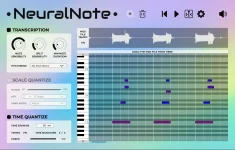Dr. Audio dropped NeuralNote 1.0.0! Users can convert their audio to MIDI right in their DAW. It is free and open source and works on Mac and Windows.
Users can now route MIDI to other instruments! They connect NeuralNote's MIDI output to another plugin. This mainly works with VST3, which has been tested in Ableton.
The DAW now sees all parameters, so users can control everything from there. The plugin remembers all settings, audio, and transcriptions between sessions. Mac saves recordings in /Users/YourUsername/Library/NeuralNote, Windows in C: UsersYourUsernameAppDataRoaming. Users just hit the bin icon to clear recordings.
The quantization features improved, too. Users can turn notes and time quantization on or off. Time quantization now works with imported audio files - they just set their tempo and time signature, and it assumes the audio starts on measure one.
Parameter changes now update the transcription much faster than before.
Core Features
NeuralNote handles any tonal instrument, including vocals. It transcribes multiple notes at once and catches all pitch bends. The engine runs fast, and users can tweak everything while listening back. They can adjust the timing and scaling of their MIDI right in the plugin.What's New Since Version 0.1.0
The installer runs smoother now. Windows users get Standalone and VST3, while Mac users can pick between Standalone, VST3, and AU during installation.Users can now route MIDI to other instruments! They connect NeuralNote's MIDI output to another plugin. This mainly works with VST3, which has been tested in Ableton.
The DAW now sees all parameters, so users can control everything from there. The plugin remembers all settings, audio, and transcriptions between sessions. Mac saves recordings in /Users/YourUsername/Library/NeuralNote, Windows in C: UsersYourUsernameAppDataRoaming. Users just hit the bin icon to clear recordings.
The quantization features improved, too. Users can turn notes and time quantization on or off. Time quantization now works with imported audio files - they just set their tempo and time signature, and it assumes the audio starts on measure one.
Parameter changes now update the transcription much faster than before.












